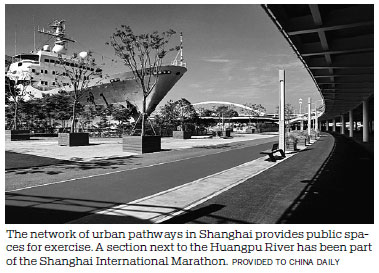In Shanghai, green paths are golden
Xie Chuntian, 67, lives near the Huangpu River in Shanghai and runs along its riverside pathways every day.
The pathways connect parks along the river and have separate lanes for walking, jogging and cycling. With a beautiful river view on one side, and trees and strips of grass on the other, the 45-kilometer trail, completed in 2018, is known as the city's No 1 greenway.
"There used to be blockages along the road, and connecting the separated short riverside trail segments was good," said Xie who started running four years ago. "Now, I can run along the river all the time, and its free from traffic and full of terrific views."
The trail was part of a municipal plan initiated in 2015 to link scattered green areas in the city and provide more natural spaces for exercise and leisure.
Zhang Yingping, deputy chief of the planning and development division of the municipal greening and appearance bureau, said the city plans to have 1,000 kilometers of pathways by 2020.
Zhang compared the city's future network of greenways to "intricate vines that grow in the modern concrete jungle", connecting residential neighborhoods, parks and facilities dedicated to sports and culture.
"The length of the pathways should not just be a number on paper. We want everyone to be immersed in the city's greenness," Zhang said.
The route of the annual Shanghai International Marathon, which attracts more than 20,000 people, includes a section along the Huangpu River in Xuhui district.
The city will also connect other riverside trails by 2035 to create nature corridors.
"Those rivers will become the backbone of the greenways in Shanghai," Zhang said.
Kate Sogor, a Hungarian who has participated in Shanghai's marathon, often runs along Suzhou Creek in Changning district, a tributary of the Huangpu, because it is close to her apartment.
"I find it beautiful and good for daily exercise," she said.
According to the municipal greening and appearance bureau, an 11.2-kilometer pathway along Suzhou Creek will be finished by the end of the year.
Fang Yan, deputy head of the bureau, said, "An inch of land is worth an inch of gold in cities like Shanghai, so building new pathways or converting existing roads to greenways is quite a difficult task."
He said coordination between municipal departments has made it possible to build 200 kilometers of pathways each year since 2016.
"The pathways are a public benefit, and their popularity has strengthened our conviction that green is gold, too," he said.
xingyi@chinadaily.com.cn

(China Daily 03/29/2019 page4)


















